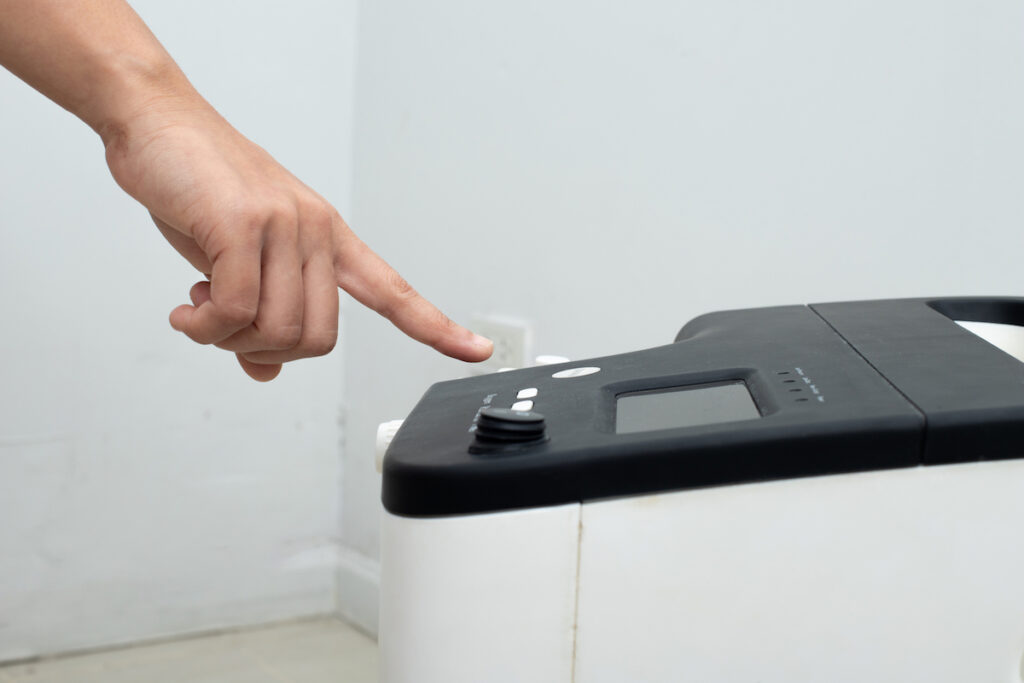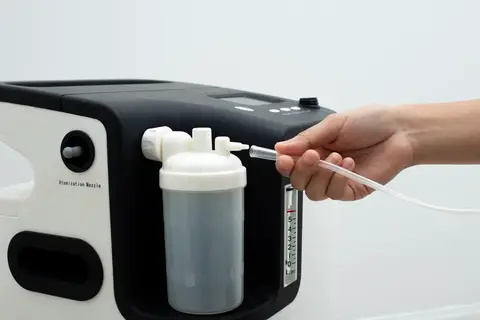A beeping oxygen concentrator generally signals an overheated device, power loss, restricted oxygen flow, or a faulty concentrator. Cleaning the machine and resetting it will usually fix most problems. However, overheating caused by damage to the internal components will require replacement of the parts (or a new oxygen concentrator)
An oxygen concentrator is specialized medical equipment that provides extra oxygen when you need it most. So it can be really frustrating when it starts to beeping and maybe even malfunctioning.
Fortunately, a few simple steps can help you fix this problem and stop your oxygen concentrator from beeping. At the end of this article you will also find helpful tips for specific brands of oxygen concentrator and links to step-by-step guides to resetting and cleaning your devices.
4 Reasons for a Beeping Oxygen Concentrator
Portable oxygen concentrators are equipped with a number of built-in features to alert us to any problems or faults.
Thankfully, beeping or blinking lights aren’t usually a cause of concern (in most cases). In fact, low power and poor airflow are the two most common reasons for a beeping oxygen concentrator – which aren’t worth panicking about, and are easily fixed!
Let’s check out what causes an oxygen concentrator to beep:
1. Overheated Unit

It isn’t uncommon for electrical devices to heat up, and the same goes for your oxygen concentrator. If you’ve placed it in an area with poor ventilation, it can overheat.
However, while inadequate ventilation is one cause of overheating, obstructed fan motors and filters can also cause this problem.
Identification:
Overheating isn’t challenging to identify. A device that is hot to touch is generally overheated.
However, a concentrator beeping with a red light can also indicate heat-related issues. Some concentrators will turn off before they become too hot to prevent damage. (Check your user guide to see if your concentrator has this fail-safe mechanism)
Solution:
- Make sure you pull the machine away from any obstructions (including walls, furniture etc) before turning it off.
- Then, wait for it to cool down and turn it on again.
- If the oxygen concentrator becomes hot again, there is likely an internal problem with the motor or filters that will require a service from a technician.
2. Power Loss

Oxygen concentrators need enough power to function efficiently.
A concentrator running low on power or out of power will sometimes also produce a beeping sound.
This is especially true if you own a portable concentrator. These types of concentrators will beep to let you know when the battery level drops to a specific percentage.
Identification
If your machine isn’t working optimally and is beeping with a solid green light, it usually indicates low power.
Solution
Powering up (recharging) your device is all it takes to solve this beeping problem. If your portable oxygen concentrator is starting to get a little old, the battery may not hold its charge like it used to.
You might have to either charge the battery more often, or even leave it plugged in (if possible).
3. Limited Oxygen Flow

Lack of oxygen flow is one of the most common causes of a beeping oxygen concentrator and, luckily, requires an easy fix.
Your oxygen concentrator will simply start beeping when it detects insufficient airflow – this generally happens due to a kinked or broken tube.
Identification
A blinking green light indicates low oxygen flow if you own a stationary oxygen concentrator.
You can also check the tube’s condition if low flow is the culprit you should see kinking or damage to the tube.
Solution
Carefully examine the oxygen tube, if you spot a winded tube, untangle it gently. If you spot some damage swap the tube for a new one to keep your device operational (and to stop the beeping).
Generally, you should receive 2-3 tubing’s with your oxygen concentrator. However, it entirely depends on the manufacturer you purchase your unit from.
And remember, it’s good practice to swap the machine’s tubing every other week to guarantee its keeps functioning properly.
4. Restricted Oxygen Production

It’s important to understand that oxygen units don’t produce their own oxygen.
Instead, they draw in the surrounding air, filter it, and provide you with concentrated oxygen. If your system begins to struggle to provide you with the required oxygen, it will start beeping.
Identification
A malfunctioning oxygen concentrator compromises oxygen production, so you will need to inspect the internal components to look for the following problems:
- the inside of the concentrator can become clogged with airborne particles
- the filter can become clogged with dust or mineral particles if you also use a humidifier
- the sieve bed can need replacing
Solution
Because the device constantly pulls in the air, it isn’t uncommon for dust particles to get stuck in it. Most oxygen concentrators feature a removable filter at the back with a tiny door.
You can open the door and clean the filter of dust and debris. If you own a pet, their hair will likely get stuck in the filter, making regular cleaning a must to ensure it keeps working properly.
Any other problem will require cleaning and/or a part to be replaced for the problem to be fixed. You may need to contact your provider or a technician as repairs could void your warranty.
Identifying the common issues is one thing, but sometimes fixing a beeping concentrator requires more than one step.
Here are a few troubleshooting steps to help you stop the concentrator from beeping and get it working again:
Troubleshooting Guide for Oxygen Concentrator Alarms
Different alarms help determine if the oxygen concentrator is malfunctioning or whether an external factor is causing the beeping. Here’s a quick troubleshooting guide for two alarm types.
Steady Alarm
- Ensure that the oxygen concentrator isn’t placed against a wall or curtain
- Unplug the system and plug it into a different outlet
- Navigate the reset button and push it to reset the device
- Check for power in your power outlet
Intermittent Alarm
- Inspect kinks in the tubing and dip the cannula in a glass of water to determine the flow
- Keep the flow ball at the prescribed flow
- Remove and replace the water bottle
Plentiful Air also has a detailed guide on how to reset your oxygen concentrator available here. It also includes all the information you need on different errors and what the yellow, red and green lights mean on your concentrator.
General Precautions to Consider
Although the design and features of oxygen concentrators differ from brand to brand, some general usage instructions remain the same. Make sure you follow the precautions listed below when using the concentrator.
- Keep the concentrator away from doors and windows to minimize dust and debris accumulation.
- Consider using a cannula instead of the face mask and hed box when delivering oxygen.
- Keep the oxygen concentrator away from open flames
- Keep oxygen cylinders handy as a backup oxygen supply in case of a malfunctioning device (this is particularly recommended for patients with severe breathing issues)
- The total flow of the flow-splitter should not exceed 4 liters per minute. Otherwise, it’ll reduce the concentration of oxygen. However, you should consult your doctor for further information related to oxygen flow.
- Avoid operating the machine on low voltage as it leads to overheating issues.
- The MJHS Health System suggests not to place books, plants, and drinks on top of the concentrator.
- Finally, avoid plugging the system into the same outlet used by other electric gadgets.
Plentiful Air also has a complete cleaning guide for oxygen concentrators and all their attachments available here.
Contact a Professional
Remember, you can always contact the device’s manufacturer for professional help. Quality brands have efficient customer support teams to help you with any troubleshooting steps.
In case of a more severe issue, you may need to take your device to them. A professional will take an hour or less to spot and fix the underlying problem.
Helpful Tips for Specific Models
Each oxygen concentrator comes with a user manual regardless of the brand. This handy document gives all the detailed information you need to know about the product and how to use it. You’ll also usually find helpful troubleshooting guides for when you have a problem.
Below, we’ve added a list of some popular oxygen concentrator brands with their basic guidelines to make the most of your device.
Invacare
The average lifespan of the Invacare concentrator is 3 years. However, it may vary depending on the intensity of use and maintenance. Here’s what the manufacturer suggests to keep your concentrator functioning at its best:
- Use a mild cleaner and damp cloth to wipe the exterior case of the device
- Let the machine air dry or use a dry towel for the purpose
- High soot and dust areas would require occasional cleaning. For instance, more debris will accumulate on the machine if you live in a region with high air pollutants.
- Inspect the filter for holes, damages, crumbles, and tears. Replace the parts as needed.
- Air drying the humidifier after thorough cleaning would reduce bacterial growth. So, let the device dry naturally after disinfecting it.
- Toss away the used accessories before sharing the device with another patient. This may include the mask, nasal cannula and tubing, and humidifier.
Learn more about the device through Invacare Oxygen Concentrator Instruction Manual.
DeVibliss
Although all Devilbiss oxygen concentrators are tested to ensure their smooth performance, you should follow a few preventive measures to ensure their hassle-free operation.
Here are some tips from the manufacturer:
- Make sure you check the oxygen concentrator with an oxygen analyzer (every 2-3 years).
- Inspect the cabinet air filter regularly to spot torn or damaged filter.
- Examine the intake and final bacteria filter and replace them if needed.
- DeVibliss healthcare recommends disinfecting the device if you lend it to someone else (even in the same household).
- Use a gentle disinfectant and let it sit for 10-15 minutes maximum.
- Wipe the concentrator components with a clean, lint-free cloth after the exposure time passes.
- Make sure you disconnect the oxygen concentrator for deep cleaning.
Further, you can check the DeVbliss Oxygen Concentrator User Manual to learn more about the setup, maintenance, troubleshooting, and component repairs and replacements.
Visionaire 5
Visionaire 5 suggests regular cleaning to ensure seamless operation of your oxygen concentrator. Follow the steps below to ensure proper care and cleaning:
- Always disconnect the power cord is before cleaning.
- Cleaning agents (e.g., detergents or soaps) often have undesirable chemicals, so it’s best to avoid pouring the liquid directly into the system. Otherwise, you may end up damaging the machine’s plastic.
- Apply a mild cleaner to a sponge and cloth and wipe all the surfaces of the concentrator.
- Make sure you dispose of the cannula periodically.
- Finally, the manufacturer does not recommend sterilization of the product. So, it’s better to avoid it.
You can read the Visionaire 5 Oxygen Concentrator User Manual to learn more about its operation, setup, safety hazards, and maintenance steps.
Inogen
Inogen gives its customers a guideline to ensure the trouble-free performance of the oxygen concentrator. Keep the following tips in mind:
- Replace the nasal cannula regularly and choose the one rated for 5 liters per minute. It will ensure proper oxygen delivery and keep the patient in good health.
- Use a gentle liquid detergent and damp cloth to clean the outside case.
- Avoid submerging the device and its components in water or detergent. It may cause electrical damage.
- Stick to the Inogen Oxygen Concentrator User Manual when choosing a detergent. Avoid using ethylene chloride, petroleum, and alcohol-based cleaning detergents.
- Clean the particle filters weekly for smooth airflow. However, you may be required to clean them regularly, depending on the environmental condition.
- Replace the output filter time and gain to keep the patient from inhaling small particles that can be detrimental to their health.
Phillips
Philip’s EverFlo Oxygen Concentrator is popular among consumers due to its quality components and efficient operation. The brand, however, recommends a few maintenance tips to boost your device’s functionality.
- It is crucial to check and replace the inlet filter every 2 years. Respironics also suggest examining and swapping micro-disk filters when needed.
- Consult your healthcare practitioner before adjusting the flow settings for the patient.
- The concentration levels must also be tweaked per the homecare provider’s policies.
- Clean the cabinets weekly and inspect to spot damages. Make sure to unclog the inlet filter holes for smooth airflow.
- The system compressor may require a replacement when the compressor’s bearings have worn out and the system’s pressure isn’t within the specified limits.
- Respironics recommends a gentle cleanser to wipe and disinfect the concentrator’s components.
Discover more about the operation, setup, and maintenance in the EverFlo Oxygen Concentrator Instruction Manual.
Plentiful Air also has a complete step-by-step cleaning guide for all the different types of Phillips oxygen concentrators available here.
